第二语言习得概论
- 格式:ppt
- 大小:2.52 MB
- 文档页数:94

二语习得理论--中文————————————————————————————————作者:————————————————————————————————日期:ﻩ二语习得定义二语习得理论概述二语习得的关键期二语习得(英语)四个阶段各阶段的教育技巧The definition of second languageacquisitionﻫOverview of Second Language AcquisitionﻫCritical period of second langu age acquisitionSecondlanguage acquisition (English)infour phasesﻫVariousstagesof education skills二语习得理论目录二语习得定义二语习得理论概述二语习得的关键期二语习得(英语)四个阶段各阶段的教育技巧第一阶段:沉默期第二阶段:英语语法干扰期第三阶段:学术英语提高期二语习得定义二语习得理论概述二语习得的关键期二语习得(英语)四个阶段各阶段的教育技巧第一阶段:沉默期第二阶段:英语语法干扰期第三阶段:学术英语提高期•第四阶段:学习曲线上升期展开目录二语习得定义二语习得理论概述二语习得的关键期二语习得(英语)四个阶段各阶段的教育技巧编辑本段二语习得定义1960年代开始,有人研究人们获得语言能力的机制,尤其是获得外语能力的机制,综合了语言学、神经语言学、语言教育学、社会学多种学科,慢慢发展出一门新的学科,叫“二语习得”,Second Language Acquisition。
编辑本段二语习得理论概述自 20 世纪70 年代以来,人们对二语习得从各个不同的方面进行了研究,所运用的研究方法也各具特色。
有的研究侧重于描写 ,有的研究偏重于假设,有的研究则采用实验。
20多年来 ,第二语言的多侧面、多方法的研究格局导致了该领域中的理论层出不穷。
目前较为流行的有:(一)乔姆斯基的普遍语法与二语习得乔姆斯基和其支持者们认为,遗传基因赋予人类普遍的语言专门知识 ,他把这种先天知识称之为“普遍语法”。
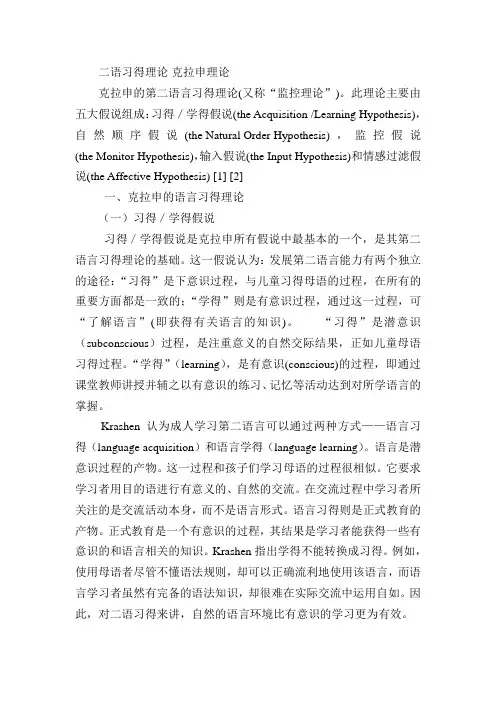
二语习得理论克拉申理论克拉申的第二语言习得理论(又称“监控理论”)。
此理论主要由五大假说组成:习得/学得假说(the Acquisition /Learning Hypothesis),自然顺序假说(the Natural Order Hypothesis),监控假说(the Monitor Hypothesis),输入假说(the Input Hypothesis)和情感过滤假说(the Affective Hypothesis) [1] [2]一、克拉申的语言习得理论(一)习得/学得假说习得/学得假说是克拉申所有假说中最基本的一个,是其第二语言习得理论的基础。
这一假说认为:发展第二语言能力有两个独立的途径:“习得”是下意识过程,与儿童习得母语的过程,在所有的重要方面都是一致的;“学得”则是有意识过程,通过这一过程,可“了解语言”(即获得有关语言的知识)。
“习得”是潜意识(subconscious)过程,是注重意义的自然交际结果,正如儿童母语习得过程。
“学得”(learning),是有意识(conscious)的过程,即通过课堂教师讲授并辅之以有意识的练习、记忆等活动达到对所学语言的掌握。
Krashen认为成人学习第二语言可以通过两种方式——语言习得(language acquisition)和语言学得(language learning)。
语言是潜意识过程的产物。
这一过程和孩子们学习母语的过程很相似。
它要求学习者用目的语进行有意义的、自然的交流。
在交流过程中学习者所关注的是交流活动本身,而不是语言形式。
语言习得则是正式教育的产物。
正式教育是一个有意识的过程,其结果是学习者能获得一些有意识的和语言相关的知识。
Krashen指出学得不能转换成习得。
例如,使用母语者尽管不懂语法规则,却可以正确流利地使用该语言,而语言学习者虽然有完备的语法知识,却很难在实际交流中运用自如。
因此,对二语习得来讲,自然的语言环境比有意识的学习更为有效。
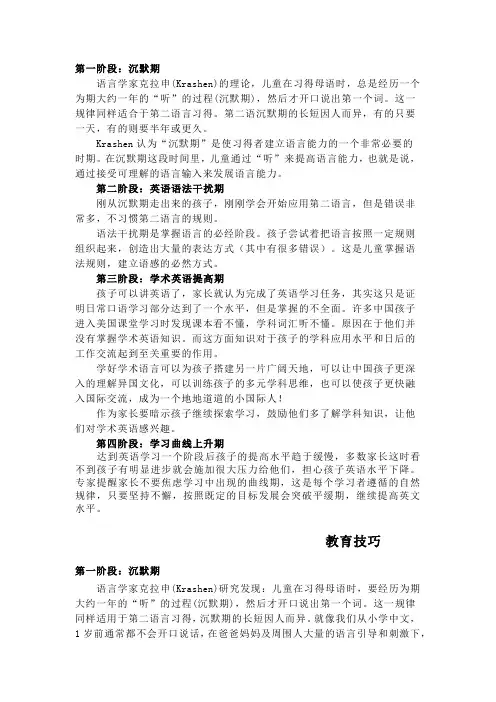
第一阶段:沉默期语言学家克拉申(Krashen)的理论,儿童在习得母语时,总是经历一个为期大约一年的“听”的过程(沉默期),然后才开口说出第一个词。
这一规律同样适合于第二语言习得。
第二语沉默期的长短因人而异,有的只要一天,有的则要半年或更久。
Krashen认为“沉默期”是使习得者建立语言能力的一个非常必要的时期。
在沉默期这段时间里,儿童通过“听”来提高语言能力,也就是说,通过接受可理解的语言输入来发展语言能力。
第二阶段:英语语法干扰期刚从沉默期走出来的孩子,刚刚学会开始应用第二语言,但是错误非常多,不习惯第二语言的规则。
语法干扰期是掌握语言的必经阶段。
孩子尝试着把语言按照一定规则组织起来,创造出大量的表达方式(其中有很多错误)。
这是儿童掌握语法规则,建立语感的必然方式。
第三阶段:学术英语提高期孩子可以讲英语了,家长就认为完成了英语学习任务,其实这只是证明日常口语学习部分达到了一个水平,但是掌握的不全面。
许多中国孩子进入美国课堂学习时发现课本看不懂,学科词汇听不懂。
原因在于他们并没有掌握学术英语知识。
而这方面知识对于孩子的学科应用水平和日后的工作交流起到至关重要的作用。
学好学术语言可以为孩子搭建另一片广阔天地,可以让中国孩子更深入的理解异国文化,可以训练孩子的多元学科思维,也可以使孩子更快融入国际交流,成为一个地地道道的小国际人!作为家长要暗示孩子继续探索学习,鼓励他们多了解学科知识,让他们对学术英语感兴趣。
第四阶段:学习曲线上升期达到英语学习一个阶段后孩子的提高水平趋于缓慢,多数家长这时看不到孩子有明显进步就会施加很大压力给他们,担心孩子英语水平下降。
专家提醒家长不要焦虑学习中出现的曲线期,这是每个学习者遵循的自然规律,只要坚持不懈,按照既定的目标发展会突破平缓期,继续提高英文水平。
教育技巧第一阶段:沉默期语言学家克拉申(Krashen)研究发现:儿童在习得母语时,要经历为期大约一年的“听”的过程(沉默期),然后才开口说出第一个词。
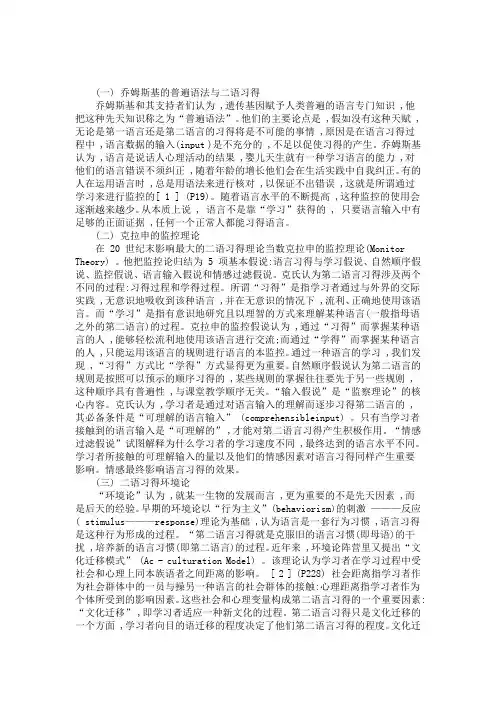
(一) 乔姆斯基的普遍语法与二语习得乔姆斯基和其支持者们认为 ,遗传基因赋予人类普遍的语言专门知识 ,他把这种先天知识称之为“普遍语法”。
他们的主要论点是 ,假如没有这种天赋 ,无论是第一语言还是第二语言的习得将是不可能的事情 ,原因是在语言习得过程中 ,语言数据的输入(input )是不充分的 ,不足以促使习得的产生。
乔姆斯基认为 ,语言是说话人心理活动的结果 ,婴儿天生就有一种学习语言的能力 ,对他们的语言错误不须纠正 ,随着年龄的增长他们会在生活实践中自我纠正。
有的人在运用语言时 ,总是用语法来进行核对 ,以保证不出错误 ,这就是所谓通过学习来进行监控的[ 1 ] (P19)。
随着语言水平的不断提高 ,这种监控的使用会逐渐越来越少。
从本质上说 , 语言不是靠“学习”获得的 , 只要语言输入中有足够的正面证据 ,任何一个正常人都能习得语言。
(二) 克拉申的监控理论在 20 世纪末影响最大的二语习得理论当数克拉申的监控理论(Monitor Theory) 。
他把监控论归结为 5 项基本假说:语言习得与学习假说、自然顺序假说、监控假说、语言输入假说和情感过滤假说。
克氏认为第二语言习得涉及两个不同的过程:习得过程和学得过程。
所谓“习得”是指学习者通过与外界的交际实践 ,无意识地吸收到该种语言 ,并在无意识的情况下 ,流利、正确地使用该语言。
而“学习”是指有意识地研究且以理智的方式来理解某种语言(一般指母语之外的第二语言)的过程。
克拉申的监控假说认为 ,通过“习得”而掌握某种语言的人 ,能够轻松流利地使用该语言进行交流;而通过“学得”而掌握某种语言的人 ,只能运用该语言的规则进行语言的本监控。
通过一种语言的学习 ,我们发现,“习得”方式比“学得”方式显得更为重要。
自然顺序假说认为第二语言的规则是按照可以预示的顺序习得的 ,某些规则的掌握往往要先于另一些规则 ,这种顺序具有普遍性 ,与课堂教学顺序无关。
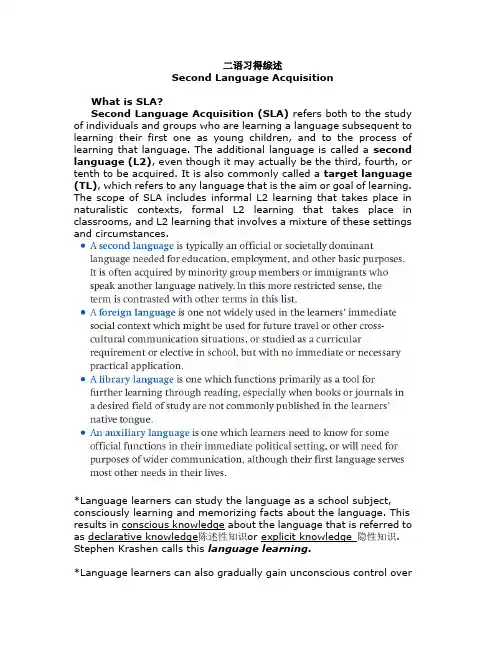
二语习得综述Second Language AcquisitionWhat is SLA?Second Language Acquisition (SLA) refers both to the study of individuals and groups who are learning a language subsequent to learning their first one as young children, and to the process of learning that language. The additional language is called a second language (L2), even though it may actually be the third, fourth, or tenth to be acquired. It is also commonly called a target language (TL), which refers to any language that is the aim or goal of learning. The scope of SLA includes informal L2 learning that takes place in naturalistic contexts, formal L2 learning that takes place in classrooms, and L2 learning that involves a mixture of these settings and circumstances.*Language learners can study the language as a school subject, consciously learning and memorizing facts about the language. This results in conscious knowledge about the language that is referred to as declarative knowledge陈述性知识or explicit knowledge 隐性知识. Stephen Krashen calls this language learning.*Language learners can also gradually gain unconscious control overthe language by using it actively for functional and communicative purposes. This results in unconscious knowledge that is referred to as procedural knowledge过程性知识or implicit knowledge显性知识. Stephen Krashen calls this language acquisition.----二语习得内隐外显学习研究-问题与思考-戴炜栋语言的本质Nature of Language语言现象有生理及心理的基础,同时也是历史及文化的产物。
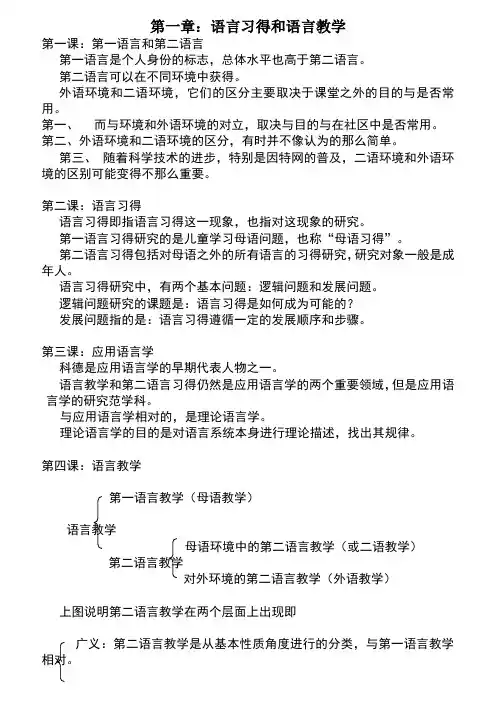
第一章:语言习得和语言教学第一课:第一语言和第二语言第一语言是个人身份的标志,总体水平也高于第二语言。
第二语言可以在不同环境中获得。
外语环境和二语环境,它们的区分主要取决于课堂之外的目的与是否常用。
第一、而与环境和外语环境的对立,取决与目的与在社区中是否常用。
第二、外语环境和二语环境的区分,有时并不像认为的那么简单。
第三、随着科学技术的进步,特别是因特网的普及,二语环境和外语环境的区别可能变得不那么重要。
第二课:语言习得语言习得即指语言习得这一现象,也指对这现象的研究。
第一语言习得研究的是儿童学习母语问题,也称“母语习得”。
第二语言习得包括对母语之外的所有语言的习得研究,研究对象一般是成年人。
语言习得研究中,有两个基本问题:逻辑问题和发展问题。
逻辑问题研究的课题是:语言习得是如何成为可能的?发展问题指的是:语言习得遵循一定的发展顺序和步骤。
第三课:应用语言学科德是应用语言学的早期代表人物之一。
语言教学和第二语言习得仍然是应用语言学的两个重要领域,但是应用语言学的研究范学科。
与应用语言学相对的,是理论语言学。
理论语言学的目的是对语言系统本身进行理论描述,找出其规律。
第四课:语言教学第一语言教学(母语教学)语言教学母语环境中的第二语言教学(或二语教学)第二语言教学对外环境的第二语言教学(外语教学)上图说明第二语言教学在两个层面上出现即广义:第二语言教学是从基本性质角度进行的分类,与第一语言教学相对。
狭义:第二语言教学是从学习环境角度进行的分类,和外语教学相对。
研究重点:学习机制、学习者语言、语言环境和语言习得、学习者个体差异。
第二语言教学研究的重点是教师和教学过程,第二语言习得研究的重点是学习和学习过程,包括中介语。
第五课:教学理念反应的是对语言学习和语言教学的基本认识。
包括:学习什么、怎样学习、如何教授。
理念是从一个人所受的全部语言教育当中,从这个人的语言学习有关的全部经历当中感悟出来的。
比较系统,有比较深厚的理论基础。
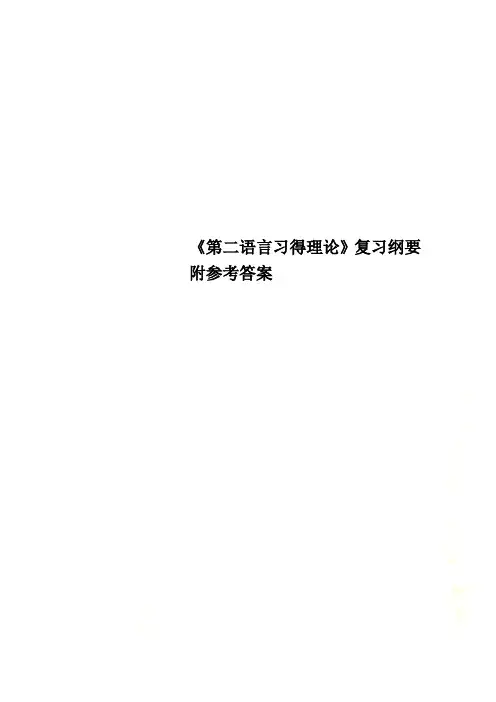
《第二语言习得理论》复习纲要附参考答案《第二语习得理论》复习纲要第一章引言1、二语习得研究者的研究对象一般是群体,而不是个体,你如何看待这个问题?10二语习得研究中,研究者的研究对象一般是群体,研究结论也是对某个群体而言。
但作为二语教学的老师,他更加关注一个个的个体,他关心的是如何让每一个学生很好的掌握第二语言。
这种情况下,二语习得研究者得到的结论,很可能对进行教学的老师的指导意义不是很大。
因此,二语习得研究者有必要加强对个体的研究,而不是局限于群体。
2、你认为什么是学外语的最好方式?9第二章人1、什么是一语习得的行为主义模型?提出者是?16-17一语习得的天生论模型的理论基础是乔姆斯基的转换生成语法,天生论认为人的大脑中有一个语言习得的机制,小孩出生后在任何一个语言环二语学习者对所学语言文化的态度影响学习过程,言语适应模型认为人们之间的交谈包含三个不同的过程,即交谈双方保持他们各自的说话方式,让各自的说话方式与对方显得越发不同,双方采用对方的说话特点以相互靠拢。
8、什么是foreigner talk?31当本族语者与非本族语者交谈时,所采用的简化的语言表达形式,可能会不符合语法规范。
9、人们一般认为学习者影响其学习效果,但Hermann提出了相反的看法,他提出的Hermann’s Resultative Hypothesis指什么?32一般认为,学习者对所学语言以及讲该语言的社会的态度会影响他学习该语言成功与否,但Hermann提出了另一个看法,称之为Hermann’s resultative hypothesis,认为可能恰好相反,学习者如果学习成功,就能促进他对该语言和讲这种语言的社会的正面态度,如果学习失败或者不太成功,他的态度会是消极的。
10、什么是语言规划?3211、人们一般把英语分为哪几个环?34-35我们一般把英语分为三个环,即inner circle,outer circle和expanding circle。
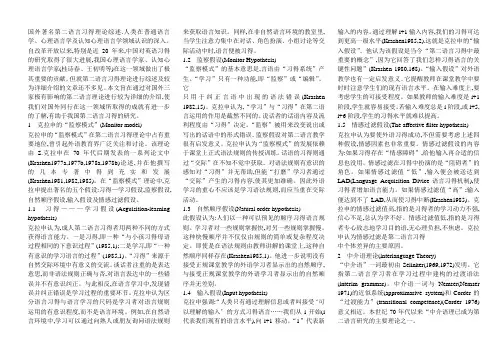
国外著名第二语言习得理论综述.人类在普通语言学、心理语言学及认知心理语言学领域认识的深入。
自改革开放以来,特别是近20年来,中国对英语习得的研究取得了很大进展,我国心理语言学家、认知心理语言学家(桂诗春、王初明等)在这一领域做出了极其重要的贡献。
但就第二语言习得理论进行综述及较为详细介绍的文章还不多见。
本文旨在通过对国外三家极有影响的第二语言理论进行较为详细的介绍,使我们对国外同行在这一领域所取得的成就有进一步的了解,有助于我国第二语言习得的研究。
1克拉申的“监察模式”(Monitor model)克拉申的“监察模式”在第二语言习得理论中占有重要地位,曾引起外语教育界广泛关注和讨论。
该理论由S.克拉申在70年代后期发表的一系列论文中(Krashen1977a,1977b,1978a,1978b)论述,并在他撰写的几本专著中得到充实和发展(Krashen1981,1982,1985)。
在“监察模式”理论中,克拉申提出著名的五个假设:习得—学习假设,监察假设,自然顺序假设,输入假设及情感过滤假设。
1.1习得———学习假设(Acguisition-learning hypothesis)克拉申认为,成人第二语言习得者用两种不同的方式获得语言能力。
一是习得,即一种“与小孩习得母语过程相同的下意识过程”(1985,1);二是学习,即“一种有意识的学习语言的过程”(1985,1)。
“习得”来源于自然交际环境中有意义的交流。
谈话者注重的是表达意思,而非语法规则正确与否,对语言表达中的一些错误并不有意识纠正。
与此相反,在语言学习中,发现错误并纠正错误是学习过程的重要环节。
克拉申认为区分语言习得与语言学习的尺码是学习者对语言规则运用的有意识程度,而不是语言环境。
例如,在自然语言环境中,学习可以通过向熟人或朋友询问语法规则来获取语言知识。
同样,在非自然语言环境的教室里,当学生注意力集中在对话、角色扮演、小组讨论等交际活动中时,语言便被习得。


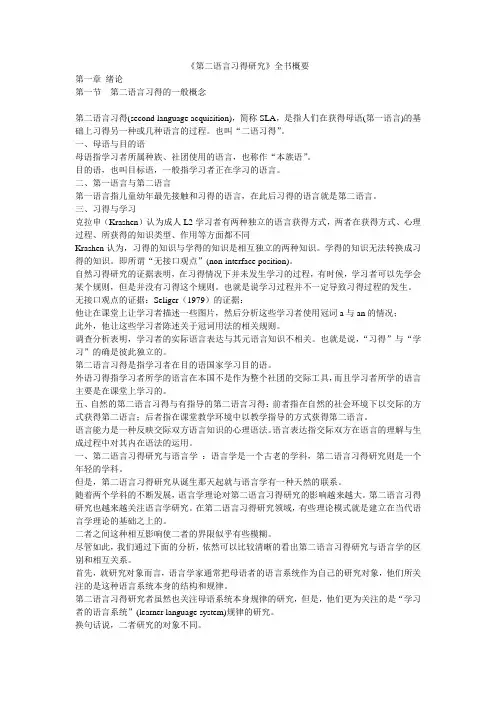
《第二语言习得研究》全书概要第一章绪论第一节第二语言习得的一般概念第二语言习得(second language acquisition),简称SLA,是指人们在获得母语(第一语言)的基础上习得另一种或几种语言的过程。
也叫“二语习得”。
一、母语与目的语母语指学习者所属种族、社团使用的语言,也称作“本族语”。
目的语,也叫目标语,一般指学习者正在学习的语言。
二、第一语言与第二语言第一语言指儿童幼年最先接触和习得的语言,在此后习得的语言就是第二语言。
三、习得与学习克拉申(Krashen)认为成人L2学习者有两种独立的语言获得方式,两者在获得方式、心理过程、所获得的知识类型、作用等方面都不同Krashen认为,习得的知识与学得的知识是相互独立的两种知识。
学得的知识无法转换成习得的知识。
即所谓“无接口观点”(non-interface position)。
自然习得研究的证据表明,在习得情况下并未发生学习的过程,有时候,学习者可以先学会某个规则,但是并没有习得这个规则。
也就是说学习过程并不一定导致习得过程的发生。
无接口观点的证据:Seliger(1979)的证据:他让在课堂上让学习者描述一些图片,然后分析这些学习者使用冠词a与an的情况;此外,他让这些学习者陈述关于冠词用法的相关规则。
调查分析表明,学习者的实际语言表达与其元语言知识不相关。
也就是说,“习得”与“学习”的确是彼此独立的。
第二语言习得是指学习者在目的语国家学习目的语。
外语习得指学习者所学的语言在本国不是作为整个社团的交际工具,而且学习者所学的语言主要是在课堂上学习的。
五、自然的第二语言习得与有指导的第二语言习得:前者指在自然的社会环境下以交际的方式获得第二语言;后者指在课堂教学环境中以教学指导的方式获得第二语言。
语言能力是一种反映交际双方语言知识的心理语法。
语言表达指交际双方在语言的理解与生成过程中对其内在语法的运用。
一、第二语言习得研究与语言学:语言学是一个古老的学科,第二语言习得研究则是一个年轻的学科。
第一章第二语言习得研究概述埃利斯(1994)明确地将第二语言习得与外语习得的概念区分开来。
“第二语言习得”是指学习者在目的语国家学习目的语。
学习者所学的目的语在目的语国家是公认的交际工具,当然也是学习者用来交际的工具。
“外语习得”是指学习者在本国学习目的语。
学习者的目的语在本国不是作为整个社团的交际工具。
这种语言学习基本上是在课堂上进行的。
“语言能力”是由交际双方内在语法规则的心理表征构成的。
简单地说,语言能力是一种反映交际双方语言知识的心理语法。
这种语法是一种隐性的语言知识。
语言能力包括:1)能指出哪些声音或语素的组合是母语中可能存在的,哪些可能是不存在的。
2)能区别符合语法的句子和不符合语法的句子。
3)能区别出一些结构相同或相似,但实际意义却不同的句子。
4)能辨别出结构不同但意义有联系的句子。
5)能辨别出句子的歧义,即同一结构具有一个以上的释义。
6)能意识到句子之间的释义关系,即结构不同的句子具有相同的语义。
“语言表达”指的是交际双方在语言的理解与生成过程中对其内在语法的表现。
关于语言运用的知识。
理想的母语者根据“递归规则”生成无限递归的句子。
第二节二语习得研究的发展一、发展阶段(一)20世纪50-60年代:理论初创阶段(二)20世纪70年代:理论大发展阶段1.偏误分析2.中介语理论假设3.习得顺序研究4.监控模式5.文化适应模式(三)20世纪80年代中期:成熟阶段1.语言学视角2.社会语言学视角3.认知视角4.社会文化视角二、理论成熟的标志1. 调查研究的领域和涉及的领域扩大2. 由理论假设发展为理论模式3. 研究方法日益科学化三、汉语作为第二语言的习得研究的发展(一)80年代,汉语习得研究起步。
1984鲁键骥“中介语理论与外国人学习汉语的语音偏误分析”1985年,第一界国际汉语教学讨论会1987年,吕必松“加强对外汉语教学的理论研究”评价:取得了一定成果,但缺乏系统研究、分析方法不够严谨、疏于解释和评价。
Second-language acquisitionFrom Wikipedia, the free encyclopediaJump to: navigation, searchSecond-language acquisition or second-language learning is the process by which people learn a second language. Second-language acquisition (often abbreviated to SLA) also refers to the scientific discipline devoted to studying that process. Second language refers to any language learned in addition to a person's first language; although the concept is named second-language acquisition, it can also incorporate the learning of third, fourth, or subsequent languages. Second-language acquisition refers to what learners do; it does not refer to practices in language teaching.The academic discipline of second-language acquisition is asub-discipline of applied linguistics. It is broad-based and relatively new. As well as the various branches of linguistics, second-language acquisition is also closely related to psychology, cognitive psychology, and education. To separate the academic discipline from the learning process itself, the terms second-language acquisition research,second-language studies, and second-language acquisition studies are also used. SLA research began as an interdisciplinary field, and because of this it is difficult to identify a precise starting date. However, it doesappear to have developed a great deal since the mid-1960s.The term acquisition was originally used to emphasize the subconscious nature of the learning process, but in recent years learning and acquisition have become largely synonymous.Second-language acquisition can incorporate heritage language learning, but it does not usually incorporate bilingualism. Most SLA researchers see bilingualism as being the end result of learning a language, not the process itself, and see the term as referring to native-like fluency. Writers in fields such as education and psychology, however, often use bilingualism loosely to refer to all forms of multilingualism.Second-language acquisition is also not to be contrasted with the acquisition of a foreign language; rather, the learning of second languages and the learning of foreign languages involve the same fundamental processes in different situations.There has been much debate about exactly how language is learned, and many issues are still unresolved. There are many theories ofsecond-language acquisition, but none are accepted as a complete explanation by all SLA researchers. Due to the interdisciplinary nature of the field of second-language acquisition, this is not expected to happen in the foreseeable future.HistoryAs SLA began as an interdisciplinary field, it is hard to pin down a precise starting date.[2] However, there are two publications in particular that are seen as instrumental to the development of the modern study of SLA: Pitt Corder's 1967 essay The Significance of Learners' Errors, and Larry Selinker's 1972 article Interlanguage. Corder's essay rejected a behaviorist account of SLA and suggested that learners made use of intrinsic internal linguistic processes; Selinker's article argued that second language learners possess their own individual linguistic systems that are independent from both the first and second languages.[7]In the 1970s the general trend in SLA was for research exploring the ideas of Corder and Selinker, and refuting behaviorist theories of language acquisition. Examples include research into error analysis, studies in transitional stages of second-language ability, and the "morpheme studies" investigating the order in which learners acquired linguistic features. The 70s were dominated by naturalistic studies of people learning English as a second language.[7]By the 1980s, the theories of Stephen Krashen had become the prominent paradigm in SLA. In his theories, often collectively known as the Input Hypothesis, Krashen suggested that language acquisition is driven solely by comprehensible input, language input that learners can understand. Krashen's model was influential in the field of SLA and also had a largeinfluence on language teaching, but it left some important processes in SLA unexplained. Research in the 1980s was characterized by the attempt to fill in these gaps. Some approaches included Lydia White's descriptions of learner competence, and Manfred Pienemann's use of speech processing models and lexical functional grammar to explain learner output. This period also saw the beginning of approaches based in other disciplines, such as the psychological approach of connectionism.[7] The 1990s saw a host of new theories introduced to the field, such as Michael Long's interaction hypothesis, Merrill Swain's output hypothesis, and Richard Schmidt's noticing hypothesis. However, the two main areas of research interest were linguistic theories of SLA based upon Noam Chomsky's universal grammar, and psychological approaches such as skill acquisition theory and connectionism. The latter category also saw the new theories of processability and input processing in this time period. The 1990s also saw the introduction of sociocultural theory, an approach to explain second-language acquisition in terms of the social environment of the learner.[7]In the 2000s research was focused on much the same areas as in the1990s, with research split into two main camps of linguistic and psychological approaches. VanPatten and Benati do not see this state of affairs as changing in the near future, pointing to the support both areas ofresearch have in the wider fields of linguistics and psychology, respectively.[7]Comparisons with first-language acquisitionPeople who learn a second language differ from children learning their first language in a number of ways. Perhaps the most striking of these is that very few adult second-language learners reach the same competence as native speakers of that language. Children learning a second language are more likely to achieve native-like fluency than adults, but in general it is very rare for someone speaking a second language to pass completely for a native speaker. When a learner's speech plateaus in this way it is known as fossilization.In addition, some errors that second-language learners make in their speech originate in their first language. For example, Spanish speakers learning English may say "Is raining" rather than "It is raining", leaving out the subject of the sentence. French speakers learning English, however, do not usually make the same mistake. This is because sentence subjects can be left out in Spanish, but not in French.[8] This influence of the first language on the second is known as language transfer.Also, when people learn a second language, the way they speak their first language changes in subtle ways. These changes can be with any aspectof language, from pronunciation and syntax to gestures the learner makes and the things they tend to notice.[9] For example, French speakers who spoke English as a second language pronounced the /t/ sound in French differently from monolingual French speakers.[10] This effect of the second language on the first led Vivian Cook to propose the idea ofmulti-competence, which sees the different languages a person speaks not as separate systems, but as related systems in their mind.[11]Learner languageLearner language is the written or spoken language produced by a learner. It is also the main type of data used in second-language acquisition research.[12] Much research in second-language acquisition is concerned with the internal representations of a language in the mind of the learner, and in how those representations change over time. It is not yet possibleto inspect these representations directly with brain scans or similar techniques, so SLA researchers are forced to make inferences about these rules from learners' speech or writing.[13]Item and system learningThere are two types of learning that second-language learners engage in. The first is item learning, or the learning of formulaic chunks of language. These chunks can be individual words, set phrases, or formulas like Can Ihave a ___? The second kind of learning is system learning, or the learning of systematic rules.[14]InterlanguageMain article: InterlanguageOriginally, attempts to describe learner language were based on comparing different languages and on analyzing learners' errors. However, these approaches weren't able to predict all the errors that learners made when in the process of learning a second language. For example,Serbo-Croat speakers learning English may say "What does Pat doing now?", although this is not a valid sentence in either language.[15]To explain these kind of systematic errors, the idea of the interlanguage was developed.[16] An interlanguage is an emerging language system in the mind of a second-language learner. A learner's interlanguage is not a deficient version of the language being learned filled with random errors, nor is it a language purely based on errors introduced from the learner's first language. Rather, it is a language in its own right, with its own systematic rules.[17] It is possible to view most aspects of language from an interlanguage perspective, including grammar, phonology, lexicon, and pragmatics.There are three different processes that influence the creation of interlanguages:[15]∙Language transfer. Learners fall back on their mother tongue to help create their language system. This is now recognized not as a mistake, but as a process that all learners go through.∙Overgeneralization. Learners use rules from the second language in a way that native speakers would not. For example, a learnermay say "I goed home", overgeneralizing the English rule ofadding -ed to create past tense verb forms.∙Simplification. Learners use a highly simplified form of language, similar to speech by children or in pidgins. This may be related to linguistic universals.The concept of interlanguage has become very widespread in SLA research, and is often a basic assumption made by researchers.[17] Sequences of acquisitionMain article: Order of acquisitionIn the 1970s several studies investigated the order in which learners acquired different grammatical structures.[19] These studies showed that there was little change in this order among learners with different first languages. Furthermore, it showed that the order was the same for adults and children, and that it did not even change if the learner had languagelessons. This proved that there were factors other than language transfer involved in learning second languages, and was a strong confirmation of the concept of interlanguage.However, the studies did not find that the orders were exactly the same. Although there were remarkable similarities in the order in which all learners learned second-language grammar, there were still some differences among individuals and among learners with different first languages. It is also difficult to tell when exactly a grammatical structure has been learned, as learners may use structures correctly in some situations but not in others. Thus it is more accurate to speak of sequences of acquisition, where particular grammatical features in a language have a fixed sequence of development, but the overall order of acquisition is less rigid.VariabilityAlthough second-language acquisition proceeds in discrete sequences, it does not progress from one step of a sequence to the next in an orderly fashion. There can be considerable variability in features of learners' interlanguage while progressing from one stage to the next.[20] For example, in one study by Rod Ellis a learner used both "No look my card" and "Don't look my card" while playing a game of bingo.[21] A small fraction of variation in interlanguage is free variation, when thelearner uses two forms interchangeably. However, most variation is systemic variation, variation which depends on the context of utterances the learner makes.[20] Forms can vary depending on linguistic context, such as whether the subject of a sentence is a pronoun or a noun; they can vary depending on social context, such as using formal expressions with superiors and informal expressions with friends; and also, they can vary depending on psycholinguistic context, or in other words, on whether learners have the chance to plan what they are going to say.[20] The causes of variability are a matter of great debate among SLA researchers.[21] Language transferMain article: Language transferOne important difference between first-language acquisition and second-language acquisition is that the process of second-language acquisition is influenced by languages that the learner already knows. This influence is known as language transfer.[22] Language transfer is a complex phenomenon resulting from interacti on between learners’ prior linguistic knowledge, the target-language input they encounter, and their cognitive processes.[23]Language transfer is not always from the learner’s native language; it can also be from a second language, or a third.[23] Neither is it limited to any particular domain of language; languagetransfer can occur in grammar, pronunciation, vocabulary, discourse, and reading.[24]One situation in which language transfer often occurs is when learners sense a similarity between a feature of a language that they already know and a corresponding feature of the interlanguage they have developed. If this happens, the acquisition of more complicated language forms may be delayed in favor of simpler language forms that resemble those of the language the learner is familiar with.[23] Learners may also decline to use some language forms at all if they are perceived as being too distant from their first language.[23]Language transfer has been the subject of several studies, and many aspects of it remain unexplained.[23] Various hypotheses have been proposed to explain language transfer, but there is no singlewidely-accepted explanation of why it occurs.[25]External factorsInput and interactionThe primary factor affecting language acquisition appears to be the input that the learner receives. Stephen Krashen took a very strong position on the importance of input, asserting that comprehensible input is all that is necessary for second-language acquisition.[26][27] Krashen pointed tostudies showing that the length of time a person stays in a foreign country is closely linked with his level of language acquisition. Further evidence for input comes from studies on reading: large amounts of free voluntary reading have a significant positive effect on learners' vocabulary, grammar, and writing.[28][29] Input is also the mechanism by which people learn languages according to the universal grammar model.[30]The type of input may also be important. One tenet of Krashen's theory is that input should not be grammatically sequenced. He claims that such sequencing, as found in language classrooms where lessons involve practicing a "structure of the day", is not necessary, and may even be harmful.[31]While input is of vital importance, Krashen's assertion that only input matters in second-language acquisition has been contradicted by more recent research. For example, students enrolled in French-language immersion programs in Canada still produced non-native-like grammar when they spoke, even though they had years of meaning-focused lessons and their listening skills were statistically native-level.[32] Output appears to play an important role, and among other things, can help provide learners with feedback, make them concentrate on the form of what they are saying, and help them to automatize their language knowledge.[33]These processes have been codified in the theory of comprehensible output.[34]Researchers have also pointed to interaction in the second language as being important for acquisition. According to Long's interaction hypothesis the conditions for acquisition are especially good when interacting in the second language; specifically, conditions are good when a breakdown in communication occurs and learners must negotiate for meaning. The modifications to speech arising from interactions like this help make input more comprehensible, provide feedback to the learner, and push learners to modify their speech.[35]Social aspectsAlthough the dominant perspective in second-language research is a cognitive one, from the early days of the discipline researchers have also acknowledged that social aspects play an important role.[36] There have been many different approaches to sociolinguistic study ofsecond-language acquisition, and indeed, according to Rod Ellis, this plurality has meant that "sociolinguistic SLA is replete with a bewildering set of terms referring to the social aspects of L2 acquisition".[37] Common to each of these approaches, however, is a rejection of language as a purely psychological phenomenon; instead, sociolinguistic research views the social context in which language islearned as essential for a proper understanding of the acquis ition process.[38]Ellis identifies three types of social structure which can affect the acquisition of second languages: socialinguistic setting, specific social factors, and situational factors.[39] Socialinguistic setting refers to the role of the second language in society, such as whether it is spoken by a majority or a minority of the population, whether its use is widespread or restricted to a few functional roles, or whether the society is predominantly bilingual or monolingual.[40] Ellis also includes the distinction of whether the second language is learned in a natural or an educational setting.[41] Specific social factors that can affectsecond-language acquisition include age, gender, social class, and ethnic identity, with ethnic identity being the one that has received most research attention.[42] Situational factors are those which vary between each social interaction. For example, a learner may use more polite language when talking to someone of higher social status, but more informal language when talking with friends.[43]There have been several models developed to explain social effects on language acquisition. Schumann's acculturation model proposes that learners' rate of development and ultimate level of language achievement is a function of the "social distance" and the "psychological distance"between learners and the second-language community. In Schumann's model the social factors are most important, but the degree to which learners are comfortable with learning the second language also plays a role.[44] Another sociolinguistic model is Gardner's socio-educational model, which was designed to explain classroom language acquisition.[45] The inter-group model proposes "ethnolinguistic vitality" as a key construct for second-language acquisition.[46]Language socialization is an approach with the premise that "linguistic and cultural knowledge are constructed through each other",[47] and saw increased attention after the year 2000.[48] Finally, Norton's theory of social identity is an attempt to codify the relationship between power, identity, and language acquisition.[49]Internal factorsInternal factors affecting second-language acquisition are those which stem from the learner's own mind. Attempts to account for the internal mechanisms of second-language acquisition can be divided into three general strands: cognitive, sociocultural, and linguistic. These explanations are not all compatible, and often differ significantly. Cognitive approachesMuch modern research in second-language acquisition has taken a cognitive approach.[50] Cognitive research is concerned with the mental processes involved in language acquisition, and how they can explain the nature of learners' language knowledge. This area of research is based in the more general area of cognitive science, and uses many concepts and models used in more general cognitive theories of learning. As such, cognitive theories view second-language acquisition as a special case of more general learning mechanisms in the brain. This puts them in direct contrast with linguistic theories, which posit that language acquisition uses a unique process different from other types of learning.[51][52]The dominant model in cognitive approaches to second-language acquisition, and indeed in all second-language acquisition research, is the computational model.[52] The computational model involves three stages. In the first stage, learners retain certain features of the language input in short-term memory. (This retained input is known as intake.) Then, learners convert some of this intake into second-language knowledge, which is stored in long-term memory. Finally, learners use thissecond-language knowledge to produce spoken output.[53] Cognitive theories attempt to codify both the nature of the mental representations of intake and language knowledge, and the mental processes which underlie these stages.In the early days of second-language acquisition research interlanguage was seen as the basic representation of second-language knowledge; however, more recent research has taken a number of different approaches in characterizing the mental representation of language knowledge.[54] There are theories that hypothesize that learner language is inherently variable,[55] and there is the functionalist perspective that sees acquisition of language as intimately tied to the function it provides.[56] Some researchers make the distinction between implicit and explicit language knowledge, and some between declarative and procedural language knowledge.[57] There have also been approaches that argue for a dual-mode system in which some language knowledge is stored as rules, and other language knowledge as items.[58]The mental processes that underlie second-language acquisition can be broken down into micro-processes and macro-processes. Micro-processes include attention;[59] working memory;[60] integration and restructuring, the process by which learners change their interlanguage systems;[61] and monitoring, the conscious attending of learners to their own language output.[62] Macro-processes include the distinction between intentional learning and incidental learning; and also the distinction between explicit and implicit learning.[63] Some of the notable cognitive theories of second-language acquisition include the nativization model, themultidimensional model and processability theory, emergentist models, the competition model, and skill-acquisition theories.[64]Other cognitive approaches have looked at learners' speech production, particularly learners' speech planning and communication strategies. Speech planning can have an effect on learners' spoken output, and research in this area has focused on how planning affects three aspects of speech: complexity, accuracy, and fluency. Of these three, planning effects on fluency has had the most research attention.[65] Communication strategies are conscious strategies that learners employ to get around any instances of communication breakdown they may experience. Their effect on second-language acquisition is unclear, with some researchers claiming they help it, and others claiming the opposite.[66] Sociocultural approachesWhile still essentially being based in the cognitive tradition, sociocultural theory has a fundamentally different set of assumptions to approaches to second-language acquisition based on the computational model.[67] Furthermore, although it is closely affiliated with other social approaches, it is a theory of mind and not of general social explanations of language acquisition. According to Ellis, "It is important to recognize ... that this paradigm, despite the label 'sociocultural' does not seek to explain how learners acquire the cultural values of the L2 but rather how knowledge ofan L2 is internalized through experiences of a sociocultural nature."[67] The origins of sociocultural theory lie in the work of Lev Vygotsky, a Russian psychologist.[68]Linguistic approachesLinguistic approaches to explaining second-language acquisition spring from the wider study of linguistics. They differ from cognitive approaches and sociocultural approaches in that they consider language knowledge to be unique and distinct from any other type of knowledge.[51][52] The linguistic research tradition in second-language acquisition has developed in relative isolation from the cognitive and sociocultural research traditions, and as of 2010 the influence from the wider field of linguistics was still strong.[50] Two main strands of research can be identified in the linguistic tradition: approaches informed by universal grammar, and typological approaches.[69]Typological universals are principles that hold for all the world's languages. They are found empirically, by surveying different languages and deducing which aspects of them could be universal; these aspects are then checked against other languages to verify the findings. The interlanguages of second-language learners have been shown to obey typological universals, and some researchers have suggested that typological universals may constrain interlanguage development.[70]The theory of universal grammar was proposed by Noam Chomsky in the 1950s, and has enjoyed considerable popularity in the field of linguistics. It is a narrowly-focused theory that only concentrates on describing the linguistic competence of an individual, as opposed to mechanisms of learning. It consists of a set of principles, which are universal and constant, and a set of parameters, which can be set differently for different languages.[71] The "universals" in universal grammar differ from typological universals in that they are a mental construct derived by researchers, whereas typological universals are readily verifiable by data from world languages.[70] It is widely accepted among researchers in the universal grammar framework that all first-language learners have access to universal grammar; this is not the case for second-language learners, however, and much research in the context of second-language acquisition has focused on what level of access learners may have.[71] Individual variationMain article: Individual variation in second-language acquisitionThere is considerable variation in the rate at which people learn second languages, and in the language level that they ultimately reach. Some learners learn quickly and reach a near-native level of competence, but others learn slowly and get stuck at relatively early stages of acquisition, despite living in the country where the language is spoken for severalyears. The reason for this disparity was first addressed with the study of language learning aptitude in the 1950s, and later with the good language learner studies in the 1970s. More recently research has focused on a number of different factors that affect individuals' language learning, in particular strategy use, social and societal influences, personality, motivation, and anxiety. The relationship between age and the ability to learn languages has also been a subject of long-standing debate.。
第二语言习得主要理论和假说一、对比分析假说(行为主义:刺激—反应—强化形成习惯)代表:拉多定义:第一语言习惯迁移问题。
两种语言结构特征相同之处产生正迁移,两种语言的差异导致负迁移。
负迁移造成第二语言习得的困难和学生的错误。
主张:第二语言习得的主要障碍来自第一语言的干扰,需要通过对比两种语言结构的异同来预测第二语言习得的难点和错误,以便在教学中采用强化手段突出重点和难点,克服母语的干扰并建立新的习惯。
影响:积极:听说法和是视听法,特别是句型替换练习的理论基础。
消极:根本缺陷——否认学习者的认知过程,忽视人的能动性和创造力。
二、中介语假说代表:塞林克基础:普遍语法理论和先天论的母语习得理论定义:中介语是指在第二语言习得过程中,学习者通过一定的学习策略,在目的语输入的基础上所形成的介于第一语言和目的语之间、随着学习进展向目的语逐渐过渡的动态的语言系统。
特点:1.中介语在其发展的任何一个阶段都是介于第一语言和目的语之间的独特的语言系统。
2.中介语是一个不断变化的动态语言系统3.中介语是由于学习者对目的语规律尚未完全掌握,所做的不全面的归纳与推论。
4.中介语的偏误有反复性5.中介语的偏误有顽固性。
在语音上易产生“僵化”或“化石化”现象。
意义:是探索第二语言习得者在习得过程中的语言系统和习得规律的假说。
把第二语言获得看做是一个逐渐积累完善的连续的过程,而且看做是学习者不断通过假设—验证主动发现规律、调整修订所获得的规律,对原有知识结构进行重组并逐渐创建目的语系统的过程。
三、内在大纲和习得顺序假说代表:科德《学习者言语错误的重要意义》反映内在大纲偏误定义:第二语言学习者在语言习得过程中有其自己的内在大纲,而学习者的种种偏误正是这种内在大纲的反映。
第二语言习得是按其内在大纲所规定的程序对输入的信息进行处理。
内在大纲实际上是人类掌握语言的客观的、普遍的规律,学习者不是被动地服从教师的教学安排、接受所教的语言知识,而是有其自身的规律和顺序。